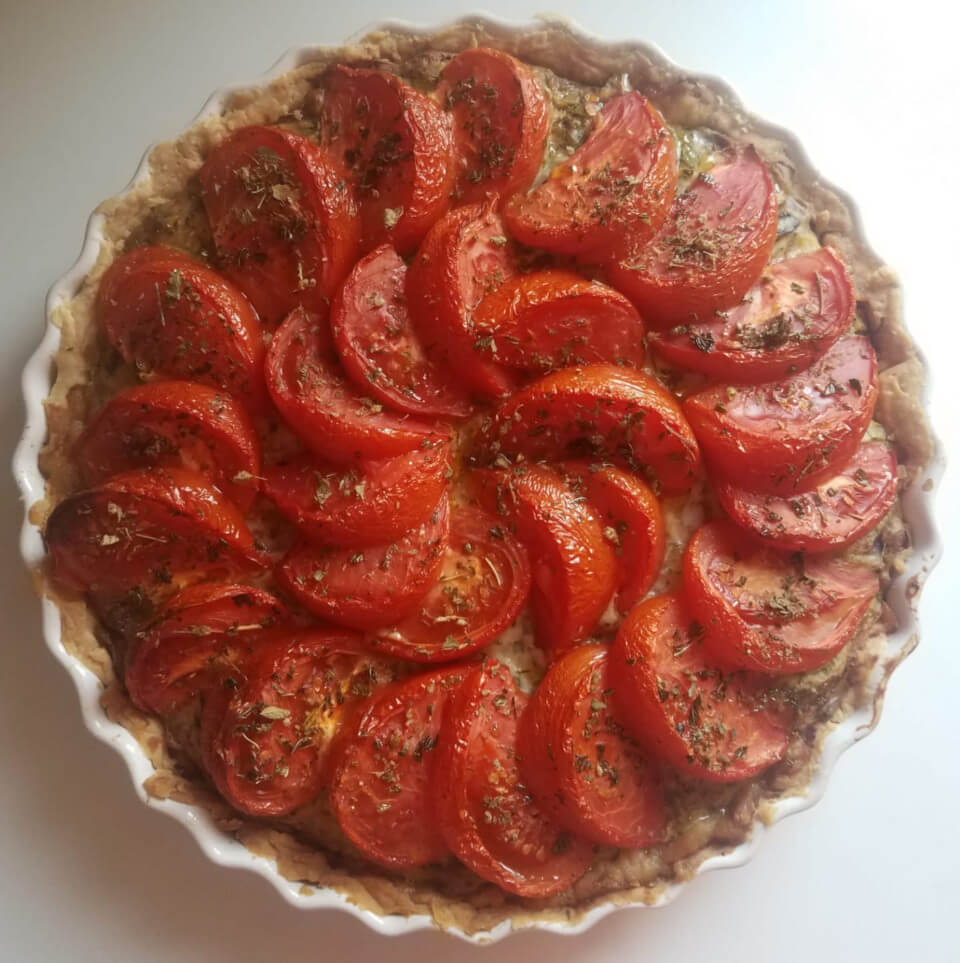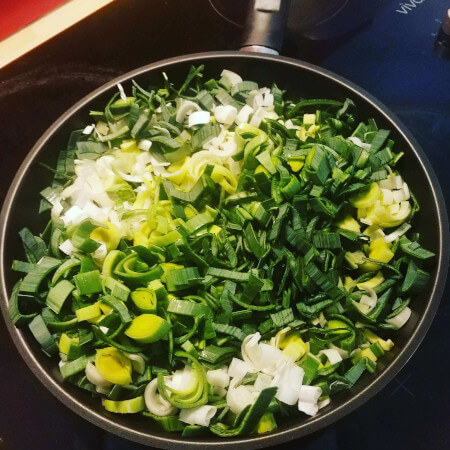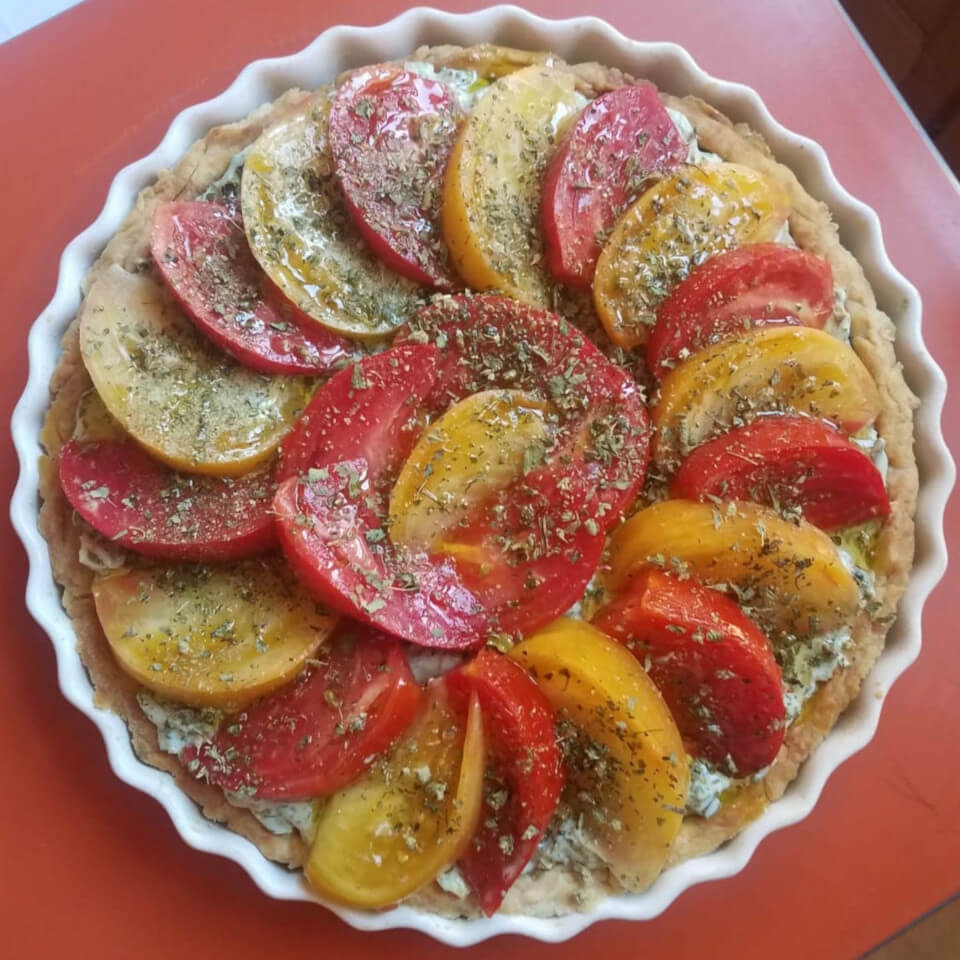
Leek & Dill Tart
This tart is rich and creamy and full of flavour. It looks pretty impressive and is a fantastic centrepiece to a nice lunch or evening meal; however, it’s definitely a dish for a special occasion as it requires quite a lot of advance preparation. It's not the kind of dish I typically make at my cooking demonstrations (I try to keep the recipes simple(r)!), but if you find you have some time to spare it is well worth the effort. What's more, it freezes perfectly and (if already sliced) can be defrosted directly in the oven.
While most vegan tarts use silken tofu in place of eggs and cream, I favour a tofu-cashew cream combination. The cashews lend the ‘custard’ a richness that tofu alone can’t equal. My preferred filling is leeks with the aniseed notes of dill and tarragon, but feel free to experiment with different vegetables and herbs. Mushrooms and courgettes also work well.
I feel that I’m pretty close to perfecting my shortcrust pastry. I've found that for every 100g flour used, 30g sunflower oil is needed. (This differs from the 2:1 ratio of flour to fat used in butter shortcrust pastry.) If you are not used to making pastry it might be a good idea to have a packet of shop bought pastry on hand, just in case! JusRoll do an excellent vegan-friendly savoury shortcrust pastry, which you can find in both the chilled aisle and the freezer. I recommend buying a block instead of the pre-rolled pastry, as the rectangular role might not fit your dish or mould.
I used a 25cm ceramic quiche dish, and had enough pastry and filling left over to make a few mini-tarts, but the quantities used in this recipe should be sufficient to fill a 28cm quiche or flan dish.
Without further ado…
For the pastry
300g plain flour
Pinch of salt
90g sunflower oil
4 tbsp (approx.) ice cold water
[Follow steps 1-3 if you are making your own pastry. If using shop-bought pastry pick up from point no. 4.]
1. Put the flour into a large bowl and mix in the salt. Make a well in the middle of the flour and pour in the sunflower oil. Using a fork, combine the oil and flour until the fat is evenly distributed and the mixture resembles fine breadcrumbs.
2. Pour in a little of the water and, using the fork, combine with the ‘breadcrumbs’. Add a little more water, and continue until a large part of the mixture starts to come together (you will still need to gather up some of the crumbs around the sides of the bowl by rolling the pastry ball over them). You will likely need to use up to 4 tbsp of water, but remember to add it little by little as you should only use as much as it takes to get the pastry to come together.
3. Cover the pastry in the bowl (or pop it into a container with a lid) and leave it to rest in the fridge for 15 minutes.

Preparing the pastry for your dish...
4. Dust a clean work surface with flour. Place the pastry on the surface and dust it lightly with flour as well. Using a rolling pin, start to roll out the pastry. After 5-6 rolls, turn the pastry over, dusting the surface again if needed (this is to keep the pastry from sticking). Continue to roll out until you are happy with the thickness.
5. Lift the pastry from the work surface and place over the quiche dish. Using your fingers, gently ease the pastry into the dish, ensuring that it it is flat to the bottom of the dish all the way round. Next press the pastry into the sides of the dish. You will need to use a knife to trim the excess pastry but leave about 1.5 cm of ‘overhang’ - i.e. do not trim the pastry tight to the top of the dish. (It is important to remember that the pastry will shrink in the oven). Using your fingertips, manipulate the overhanging pastry so that it forms a little ridge on the inside of the dish (see photo above!).
6. Prick the pastry in the bottom of the dish several times with a fork. Gently lower a sheet of baking parchment into the dish, pressing the paper down into the sides. Fill the dish with baking beans (these keep the pastry weighed down while you ‘blind bake’ the pastry). If you don't have ceramic baking beans you can use dried kidney beans or other dried pulses.
7. Place the dish in an oven preheated to 200ºC for about 15-20 minutes until the crust begins to turn golden. Remove from the oven. Gather up the corners of the baking parchment and carefully remove the baking beans. It’s a good idea to have a heatproof bowl on hand to transfer the beans to. Return the dish to the oven and bake for another 10 minutes or so until the pastry base turns golden as well. Keep an eye on it during this time as you don’t want the pastry to burn! If it hasn’t turned golden within this time leave it in the oven a little longer.


For the filling
2 tbsp sunflower oil
2 large onions, chopped
4 tbsp extra virgin olive oil for frying, plus a further 4 tbsp later in the recipe
1 kg leeks washed and sliced
1 x 350g block of silken tofu, excess water drained off
45g cornflour
1 1/2 tsp salt
Several twists of freshly ground black pepper
100g raw cashew nuts, soaked in water for at least an hour
100 ml soya milk
25g nutritional yeast
Large bunch of dill, rinsed, de-stalked and roughly chopped
Small bunch of tarragon, rinsed, de-stalked and chopped
There is a bit of advance preparation needed here. Everything will run smoother if you do these few things ahead of time:
- Soak the cashews in water for at least an hour.
- Place the block of tofu on a few sheets of kitchen paper to absorb the excess water. You will need to replace the paper several times.
- Wash and slice the leeks. 1kg is about 4 medium sized leeks.
- Wash and de-stalk the herbs.
To begin...
1. Heat the sunflower oil in a large pan and add the onions. Stir often and fry until browned. Transfer the cooked onions to a small bowl and set aside.
2. Add 4 tbsp of extra virgin oil to the pan and put on a medium heat. Add the leeks. Leeks are quite bulky so depending on the size of your pan, you might need to cook them in two separate pans, or do a batch at a time. If you do this, remember to use 2 tbsp olive oil per 500g of leeks. Stir the leeks often so that they cook evenly and do not burn or stick to the bottom of the pan. Cooking time may take up to 30 minutes. The aim is to let as much water evaporate as possible and to allow the leeks to caramelise. When finished, transfer the leeks to a large heatproof bowl and set aside to cool.
3. Prepare the filling. Put the silken tofu, cornflour, remaining 4 tbsp (60ml) extra virgin olive oil, salt and pepper into a food processor and process until smooth.
4. Drain and rinse the cashew nuts. Place the nuts in a blender with the soya milk and nutritional yeast and blend until smooth. If you don’t have a standalone blender, put the ingredients into a cylindrical container and blitz with a hand blender. I recommend using a blender or hand blender instead of adding the cashews directly into the food processor because (unless your food processor is extremely powerful) it is unlikely that the cashews will be broken down completely. That's important here because the cashews give the filling its creaminess.
5. Add the cashew cream to the food processor and process with the tofu mixture for a few seconds until they are mixed together.
6. Stir the tofu/cashew cream and chopped herbs into the leeks. You might wish to adjust the seasoning, so have some salt and pepper to hand.
Assembling the tart
To garnish you’ll need…
4-5 large tomatoes thickly sliced
Extra virgin olive oil for drizzling
Dried oregano for sprinkling on top (about 1 tbsp)
1. Spread out the cooked onions onto the base of the pastry crust. Use the back of a spoon to spread them out evenly and all the way to the sides.
2. Spoon the leek mixture on top of the onions and fill the pastry case until the mixture is level with the top of the crust.
3. Arrange the tomatoes on top before sprinkling with oregano and drizzling with olive oil.
4. Bake at 180ºC for 1 hour.
The tart is good to eat right away, but I think it’s even better the day after. If you decide to freeze it, it’s a good idea to cut it into pieces first so that you can defrost them individually. Serve with salad and roast potatoes, or whatever takes your fancy.







